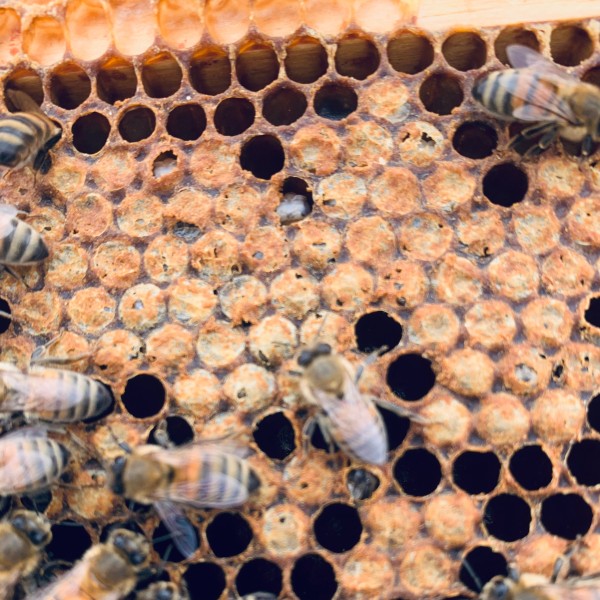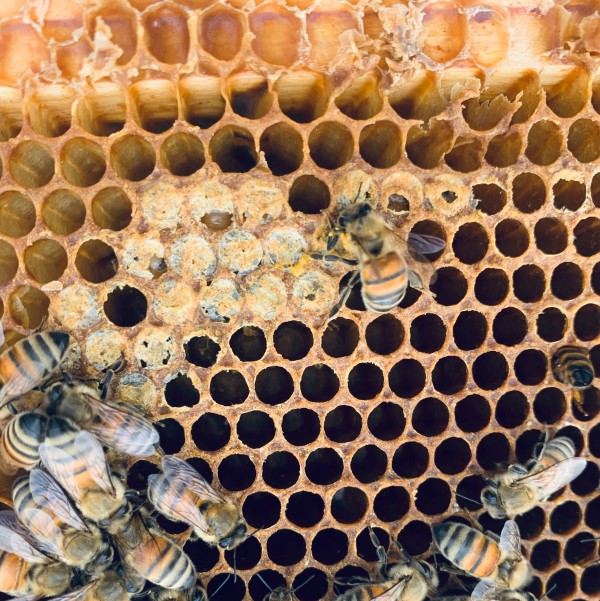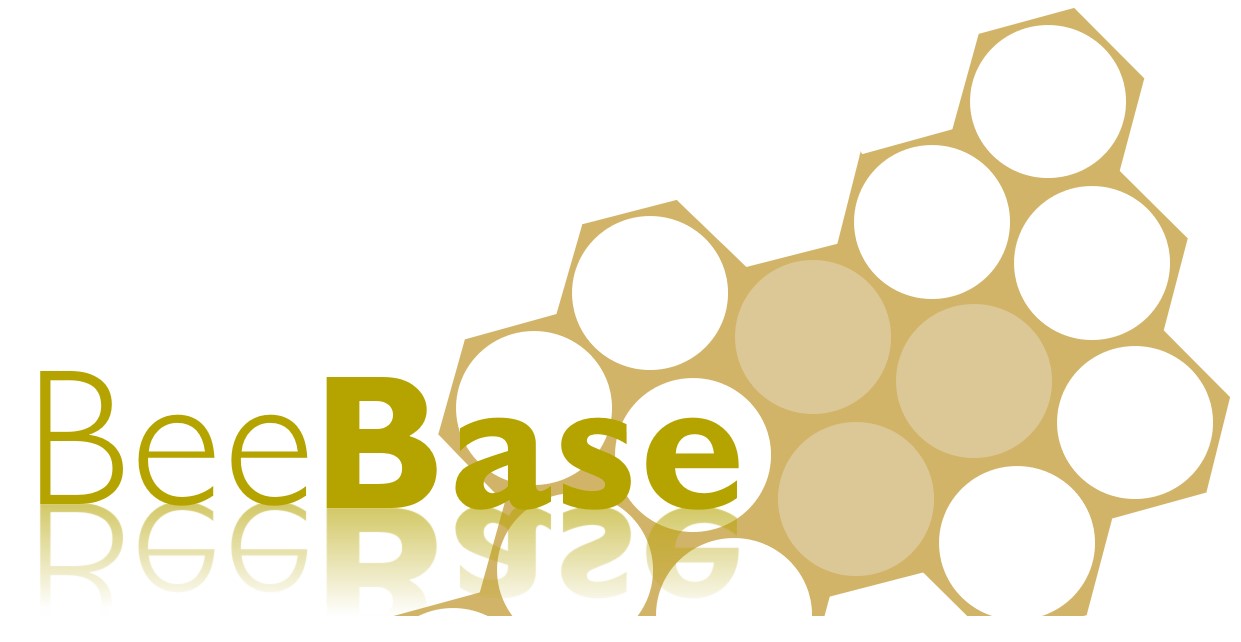Starvation of honey bees - recognition and prevention
During prolonged cold, wet periods and/or when there is a lack of forage, honey bee colonies may use up all their honey or sugar stores. This can frequently happen in spring when colonies are using up their last remaining winter stores to rear brood. Once a colony runs out of stores, it can die of starvation very quickly. Loss of bees from starvation is avoidable with the right care and attention.
David Wilkinson, former Apiary Manager at the NBU, explains how to recognise the signs of starvation, and the urgent actions you should take.
 |
 |
These bees are starving
The above photos show abnormal, perforated brood cappings observed after a long, cold, wet spring. The bees have nibbled holes in the brood cappings.
Nibbled brood cappings can be signs of foulbrood, heavy Varroa infestation, chilled brood, or starvation.
In the above case you can just see parts of white pupae through the holes in the cappings. If it were American Foulbrood (AFB) you would expect brown larval/pupal remains or dark scales below those cappings; and European Foulbrood usually presents as discoloured/contorted/‘melted-down’ larvae before they are capped. Of course, foulbrood could also be present in the colony, so a thorough inspection of the brood for signs of foulbrood should be performed as soon as the weather permits. For more guidance on recognising signs of foulbrood, please view our foulbrood advisory leaflet.
The pictured colony had been well-treated for Varroa; and it was a large colony, so the brood was not chilled. Starvation was the cause.
Signs of colony starvation
- Nibbled cappings with healthy looking pupae beneath is a typical sign of imminent starvation.
- All the cells around the brood nest where you would expect to find honey/syrup stores are dry.
- The bees are desperately nibbling at the brood cappings, presumably in search of food. Sometimes they will remove pupae and drop them on the floor or throw them out of the entrance.
- The bees at that point may well be very lethargic, as a lack of food means they have no energy. They will crawl into cells head first, and at that point, the whole colony can die very quickly.
Urgent action
- If the bees are on the brink of starvation (see signs above), then feed them without delay.
Or if the bees only have one or two combs of stores, feed them the same day, or at least within a day or two. - The ideal way to feed bees is with stored combs of honey taken previously from your own bees, or spare combs of honey taken from another of your hives in the apiary, providing that the donor hive is left with ample stores for itself.
Important: Because of the risk of spreading infection, if there is a history of foulbrood in your apiary within the last five years, or if an alert of foulbrood in your area has recently been received, such combs should not be used, unless it is stored comb that is clearly labelled and you know it is going back to the same colony it came from.
If the honey comb(s) are all capped, scratch off a few cappings, so the starving bees can get instant access. Insert the stores to flank the brood, or in the middle if the bees are beginning to succumb.
- Alternatively, feed with a thick sugar syrup (warmed up), or feed your own honey back, provided you haven’t had foulbrood in your apiary. Never feed other people’s honey or bought honey as this presents a serious risk of infecting your bees with foulbrood.
Thick sugar syrup is 2 lbs white granulated sugar to 1 pint of water, or 1 kg to 625 ml. A frame feeder is good, as it gives the bees quick and easy access. If the bees are lethargic and at risk of being unable to reach the syrup, dribble small amounts directly on the bees between the seams (please don’t overdo this, as too many sticky bees can cause a problem); approximately 2 to 3 ml per seam will suffice, as this is just enough to get them active and able to climb up to a rapid or contact feeder. Syrup can be sprayed onto the bees, instead of dribbling, but may need to be thinned down with water to give a fine spray.
Another good way to give lethargic bees quick access to feed is to fill cells of one side of an empty comb with sugar syrup by laying the frame flat in a tray and squirting syrup from the nozzle of a thoroughly cleaned out washing-up-liquid bottle, or spraying from a jar with 3 mm holes in the lid, or pouring it out bit by bit, whilst shaking/tilting/knocking the frame. Carefully lower the frame amongst the bees. When the bees are more active, they will hopefully reach a rapid or contact feeder.
- Alternatively, feed fondant, but you need to get it close enough to the bees so they can find it. If the bees are lethargic and it’s cold, they may not find the fondant above a feed hole. It is better to place the fondant across the tops of the brood frames within an eke.
Vital checks
- Heft the hives. With experience you will learn what is sufficiently heavy and a good sign that stores are ample. BUT brood and pollen can add up to a fairly heavy hive, so don’t stop there.
- Inspect some of the combs. Check the hive every week or two during a cold, wet spring or at other times of dearth. If there is a super that’s half-full of honey (or more), then you can be confident that there is little risk of starvation. If there’s no heavy super, then check the brood box. Don’t worry about the brood getting chilled, because you don’t need to take combs of brood right out of the hive, shake bees off combs, or leave combs outside the hive. If you have a double brood-box, you probably only need to check the top one, as that’s where the stores are likely to be; hence you may not need to separate the boxes. If the top brood-box is a half (shallow) you may need to check below as well.
- Lift each comb halfway-out so you can see whether it’s brood or stores. Roughly assess the weight of honey/syrup stores of each comb (none/quarter/half/three-quarters/one). Sum-up the combs of honey/syrup stores. Work-in from one side until you reach combs of brood and (virtually) no honey, then switch and work-in from the other side. Sum them up in your head as you go (or write it down or get your assistant to write it down). Count shallow frames as equivalent to half-deeps.
- A good rule is that the minimum requirement is two full deep combs of honey/syrup stores. If the summed total is equivalent to less than that, then the bees may not have enough to last a fortnight and at the next inspection you might find that the colony has died. If they are short on stores, you need to take urgent action, as described above.
Sometimes, if the weather is “unkind” to them, it’s the biggest/best colonies that are at most risk of starvation, especially in the spring when they are turning lots of stores into brood. It can be particularly upsetting to lose the very colonies that had the best potential for giving bumper honey crops!
